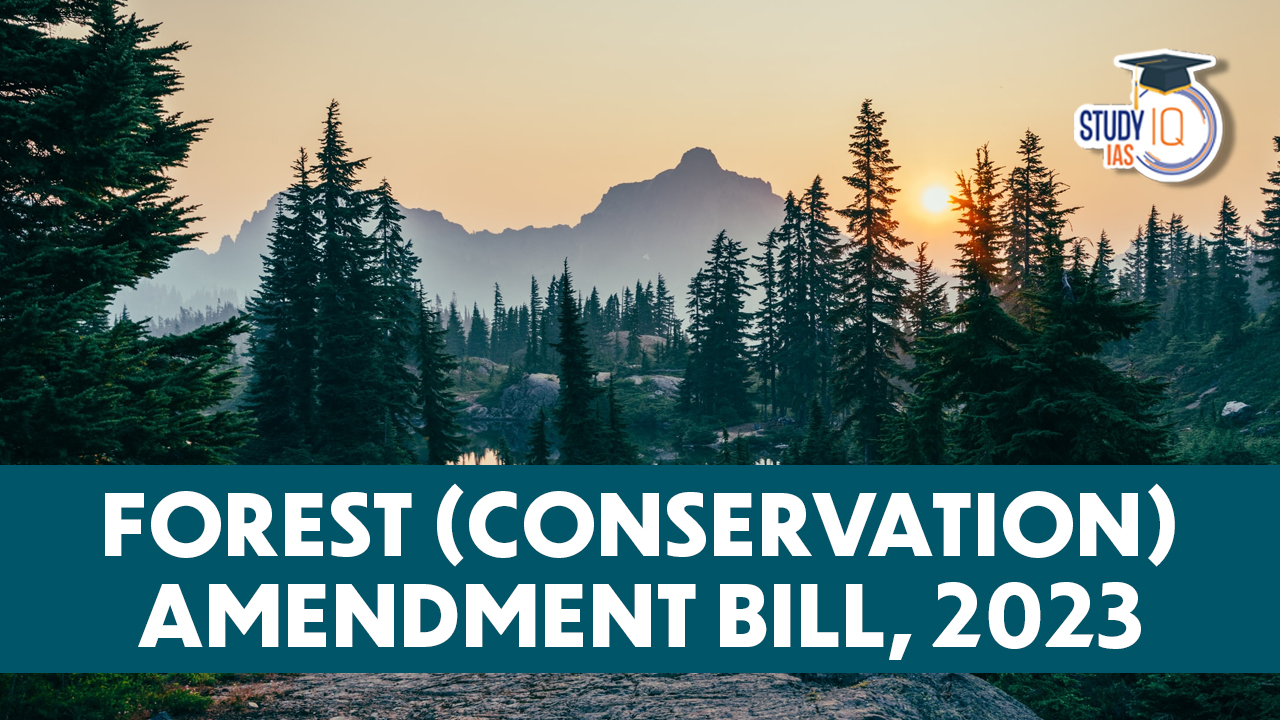Table of Contents
Context: The Lok Sabha passed the Forest Conservation (Amendment) Bill 2023, which seeks to amend the Forest (Conservation) Act, 1980.
Background: The Forest (Conservation) Act, 1980
- The Forest Conservation Act 1980 is an important legislation enacted by the Government of India to regulate the diversion of forestland for non-forestry purposes.
- The Act was passed in response to the growing concern over the rapid depletion of India’s forests, which had serious environmental and ecological consequences.
- Key features of the Forest (Conservation) Act, 1980:
- Central government approval: The Act mandates that the diversion of forestland for non-forestry purposes can only be approved by the central government.
- Consultation: The Act mandates that state governments and tribal communities be consulted before approving the diversion of forestland. The consultation process ensures that the views of local stakeholders are considered, and their concerns are addressed.
- Compensation for loss of forest cover: The Act requires the payment of compensation for the loss of forest cover due to the diversion of forestland. The amount of compensation is based on the net present value of the diverted forestland, and the funds collected are utilized for afforestation and reforestation activities.
- Mandatory undertaking for compensatory afforestation: The Act requires that an equal area of non-forest land be afforested or reforested as a compensatory measure for the loss of forestland due to diversion. The undertaking for compensatory afforestation is mandatory and non-compliance can result in penalties.
- Deemed forests: The Act recognizes the concept of “deemed forests,” which refers to areas that are not officially classified as forests but are ecologically sensitive and have forest-like characteristics. Such areas are also subject to the Act’s provisions and require the central government’s approval for any diversion.
- Penalties for violation: The Act provides for penalties, including imprisonment of up to 15 months and a fine of up to Rs. 10,000, or both, for violation of its provisions.
Key highlights of the Forest (Conservation) Amendment Bill, 2023
- Land under the purview of the Act: The Bill amends the Forest (Conservation) Act, 1980 to make it applicable to certain types of land. These include land notified as a forest under the Indian Forest Act, 1927 or in government records after the 1980 Act came into effect. The Act will not be applicable for land converted to non-forest use before December 12, 1996.
- Exempted categories of land: It also exempts certain types of land from the purview of the Act. These include land within 100 km of India’s border needed for national security projects, small roadside amenities, and public roads leading to a habitation.
- Assignment/leasing of forest land: The state government requires prior approval of the central government to assign any forest land to a private entity. The Bill extends this to all entities, and allows the assignment to be made on terms and conditions specified by the central government.
- Permitted activities in forest land: The Act specifies some activities that can be carried out in forests, such as establishing check posts, fencing, and bridges. The Bill also allows running zoos, safaris and eco-tourism facilities.
Criticism of the Bill
- Dilution of forest protection: One of the major objections raised is that the proposed amendments dilute the Supreme Court’s 1996 judgment in the Godavarman case, which extended protection to wide tracts of forests, even if they were not officially recorded as forests. Critics argue that the amendments compromise the integrity of forest protection.
- Exemptions in geographically sensitive areas: The bill exempts the construction of highways, hydel power projects, and other projects in geographically sensitive areas within 100 km of international borders or the Line of Control from requiring forest clearance. This exemption is seen as problematic and could potentially lead to environmental degradation in sensitive regions.
- Lack of central protection for deemed forests: The amendments remove central protection for vast tracts of so-called “deemed forest” areas, which are forests not officially recorded as forests. This removal of protection raises concerns about the integrity of these forests and opens them up to activities such as tourism, which could further compromise their ecological balance.
- Diversion for commercial purpose: The bill limits the application of Forest Conservation Act to ensure diversion of forests for use by public and private sector and advance the agenda for ‘ease of businesses.
- Insufficient focus on dense forests: While the amendments encourage plantation cultivation to increase tree cover, critics argue that they fail to address the loss of dense forests. The focus on increasing tree cover through plantations may not effectively tackle the decline in regions classified as dense forest, where the canopy density is higher.
Evolution of Forest Laws in India
- Memorandum on forest conservation 1856: For the first time, in 1856, Lord Dalhousie emphasized the need for a definite forest policy.
- Railways were first introduced to India in 1853. Increasing difficulty of obtaining adequate supplies of timber was one of the main reasons for this cognisance.
- The Indian Forests Act of 1865: The Imperial Forest Department, set up in 1864, attempted to establish British control over forests, by various legislations.
- It empowered the British government to declare any land covered with trees as a government forest and make rules to manage it.
- The Forest Act of 1878: By the Forest Act of 1878, the British Administration acquired the sovereignty of all wastelands which by definition included forests.
- This Act classified the forests into three – reserved forests, protected forests and village forests.
- Degree of protection: Reserved forests > Protected forests > Village forests
- It attempted to regulate the collection of forest produce by forest dwellers and some activities declared as offences.
- The Indian Forest Act, 1927: This Act impacted the life of forest-dependent communities.
- The penalties and procedures given in this Act aimed to extend the state’s control over forests as well as diminishing the status of people’s rights to forest use.
- Indian Forest Policy, 1952: The Indian Forest Policy, 1952 was a simple extension of colonial forest policy.
- Forest Conservation Act, 1980: It was enacted by the Parliament of India in order to control the ongoing deforestation of the forests of India.
- National Forest Policy 1988: This was a drastic shift in the approach towards management of forests.
- The National Forest Policy 1988 envisages to have a minimum of one-third of the total land area of the country under forest or tree cover.


 Gujarat Judiciary Syllabus And Exam Patt...
Gujarat Judiciary Syllabus And Exam Patt...
 Gujarat Judiciary Notification 2025 Out ...
Gujarat Judiciary Notification 2025 Out ...
 Best Test Series for Gujarat Judiciary E...
Best Test Series for Gujarat Judiciary E...




















